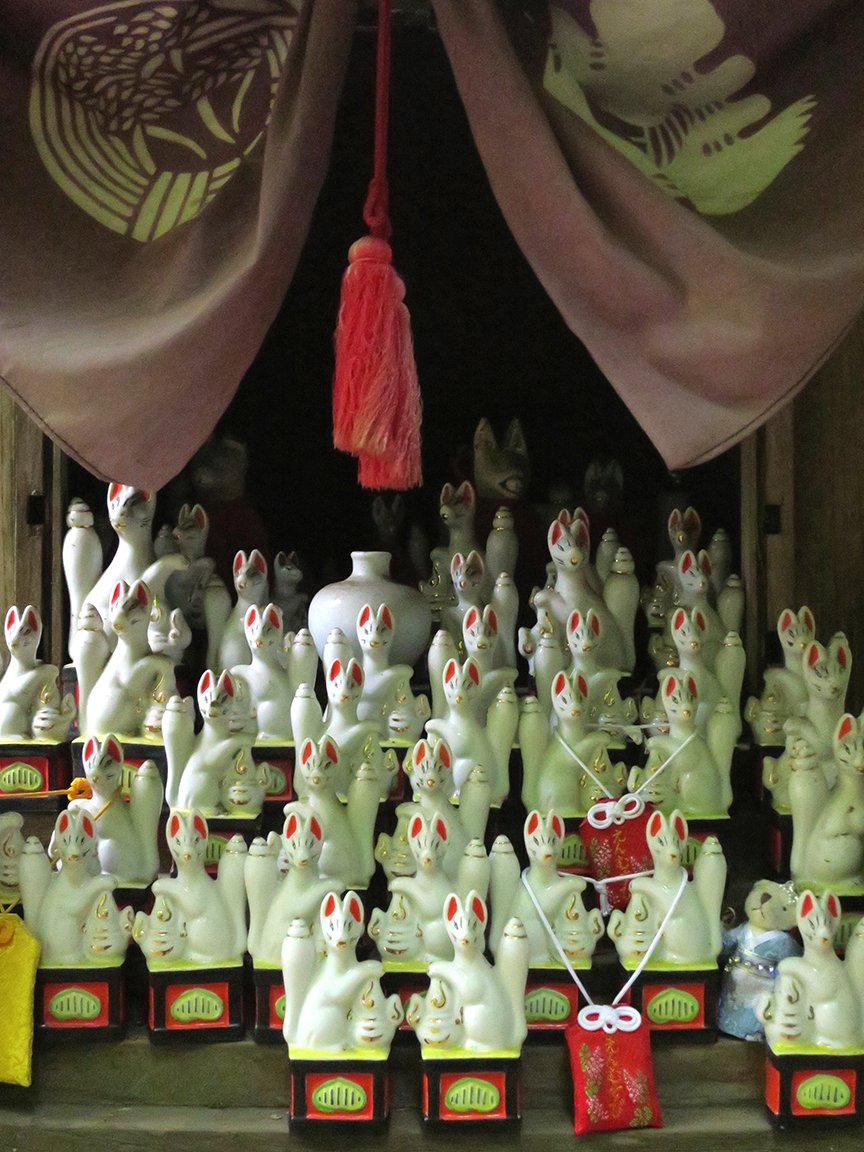Altar
Image Credit: Courtesy of Lilla Green, from the article "Fushimi Inari Taisha Shrine Travel Guide"
Website: lillagreen.com
The word “Inari” is an abbreviated term for “Ine Nari” or “Ine ni naru,” which translates to “reaping of rice.”
Inari or Inari Okami is the Japanese kami of improvement in the performing arts, household wellbeing, business prosperity, and general prosperity. Inari is also attributed to rice, sake, tea, fertility, foxes, agriculture, and industry. The ancient Japanese word stems from the importance of rice in the daily Japanese diet and symbolizes the miracles of heaven and earth. As one of the principal deities of Shinto, Inari houses, feeds, and protects all people so that they may live a fulfilling life. Inari is one of the most widely venerated kami in Japanese culture.
Kobo Daishi understood Inari's significance and built a shrine for the kami and inscribed on it the Chinese characters for "rice" and "sack".
A Procession Led by Foxes
This nishiki-e was designed and produced to be used on a round, flat uchiwa fan. Holding up hoes and shovels as if the farm tools are long decorated spears suitable for a lord’s procession, farmers are led by foxes across a bridge which spans the river. A torii gate can be seen in the distance; perhaps the gate to an Inari shrine sacred to foxes. Edo period, one sheet
The entrance to an Inari shrine is typically marked by one or more vermilion torii and images of foxes, which are often adorned with red yodarekake (votive bibs) by worshippers out of respect. The color red has come to be identified with Inari because of the prevalence of its use among Inari shrines and their torii.
Inari shrines typically possess guardian figures in the form of foxes or kitsune. These guardian figures are messengers of Inari but are commonly thought of as the deity itself.
Fushimi Inari Taisha Fox Shrine Temple with Kaiju (2023),
Kevin Clark
Washi, ink woodblock print,
18 x 21 in
Kitsune often appear as male-female pairs guarding shrine entrances, but their dualistic nature raises questions: are they good or bad, helpful or malicious? Are they deities in their own right or merely messengers? Was their messenger role a syncretic adaptation to ensure the survival of fox worship folded into the Inari tradition during the Meiji Restoration's religious reforms?
Offerings of rice, sake, and other foods are given at the shrine to appease and please these kitsune messengers, who are then expected to plead with Inari on the worshipper's behalf. Inari-zushi, a Japanese sushi roll of rice-packed fried tofu, is another popular offering.
Often fox statues hold a symbolic item in their mouths or beneath a front paw. The items may include a jewel or a key which are most common but, a sheaf of rice, a scroll, or a fox cub are also popular. The statues are rarely realistic; they are typically stylized, portraying a seated animal with its tail in the air looking forward. Despite these common characteristics, the statues are highly individualistic in nature and no two are exactly the same.
Fox statues are often offered to Inari shrines by worshippers, and on occasion a stuffed and mounted fox is presented to a temple.
Image Credit: Courtesy of Jonelle Patrick, from the article "The Fox Shrine To End All Fox Shrines"
Website: jonellepatrick.me





